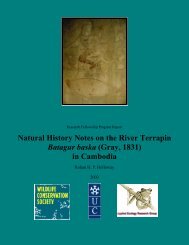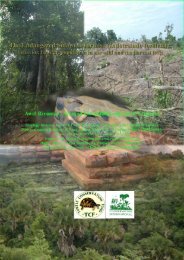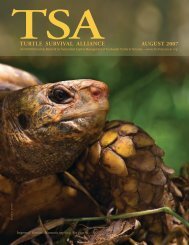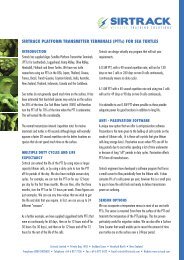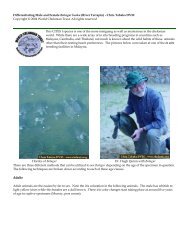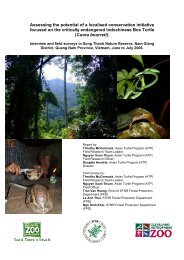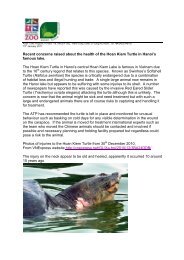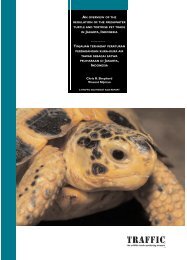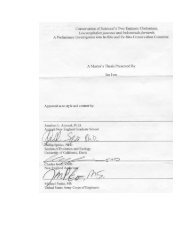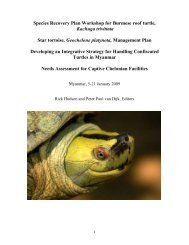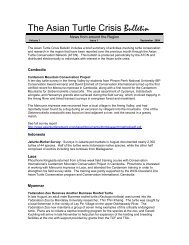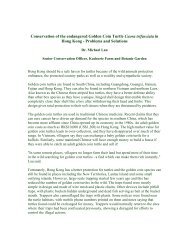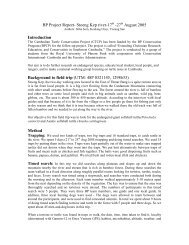Turtle Conservation Fund - Species Recovery Plan for Batagur baska
Turtle Conservation Fund - Species Recovery Plan for Batagur baska
Turtle Conservation Fund - Species Recovery Plan for Batagur baska
You also want an ePaper? Increase the reach of your titles
YUMPU automatically turns print PDFs into web optimized ePapers that Google loves.
Protected Status:<br />
CITES I<br />
Quotas: (unknown)<br />
The species is fully protected from all <strong>for</strong>ms of exploitation under domestic<br />
legislation in India, Indonesia, Myanmar and Thailand. It is scheduled <strong>for</strong> inclusion<br />
in as-yet unapproved legislation in Cambodia, and is not legally protected in<br />
Bangladesh and Vietnam (though export would be prohibited under their CITES<br />
obligations) (P.P. van Dijk, personal Communication).<br />
<strong>Conservation</strong> Status:<br />
IUCN Red List –Critically Endangered<br />
Summary of trade and threats: Presumed extinct in Myanmar, Vietnam, and<br />
Singapore. Eggs and adults are over exploited <strong>for</strong> food. Populations<br />
are also declining due to destruction of mangrove <strong>for</strong>ests, sand<br />
mining, damming of rivers (Moll, 1990; Moll and Moll, 2000), and<br />
probably pollution (P.P. van Dijk, personal communication) (see<br />
conservation and research needs section below <strong>for</strong> more details).<br />
Status In Captivity:<br />
20.35.50 (105) from 13 institutions listed worldwide in ISIS and in<br />
the international studbook currently under preparation at Cleveland Metroparks<br />
Zoo (Table 1).<br />
<strong>Batagur</strong> has successfully reproduced outside Asia only at the Bronx Zoo. One<br />
female there produced four clutches over eleven years (1990, 1995, 1999, 2001).<br />
Reproductive success in Asian collections is not fully known at this time;<br />
however, head starting, captive propagation and/or hatchery programs exist in<br />
the following countries:<br />
1. Malaysia: This program is administered by the Department of Wildlife and<br />
National Parks – PERHILITAN, in conjunction with District Offices. Captive<br />
breeding facilities <strong>for</strong> <strong>Batagur</strong> are located at a) Bota Kanan in Perak<br />
(established in 1968), b) Bukit Paloh in Terengganu (established in 1976),<br />
and c) Bukit Pinang in Kedah (established in 1978) (bin Abdul, 1998).<br />
2. Thailand: A <strong>Batagur</strong> breeding facility is located at the Thai Fisheries<br />
Department’s Satun Freshwater Fisheries Development Station at La-nguin<br />
in Satun Province.<br />
3. India: Eggs are removed from West Bengal Forest Department Project Tiger<br />
Sanctuary at Bagmara to a hatchery at Pakhiralaya.<br />
Reproduction is fairly widespread in these facilities, but training is needed in<br />
husbandry, veterinary care and egg incubation techniques (Moll and Moll, 2000;<br />
P.P. van Dijk, personal communication).



